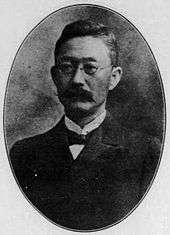Nunobiki Maru
| History | |
|---|---|
| Name: | Nunobiki Maru |
| Builder: | Caird & Company, Greenock, Scotland |
| Completed: | 1874 |
| Fate: | Foundered 21 July 1899 |
| General characteristics | |
| Type: | Steamship |
| Tonnage: | 1,336 grt |
| Length: | 79.3 m (260 ft 2 in) overall |
| Beam: | 9.2 m (30 ft 2 in) |
| Propulsion: | compound steam engine |
Nunobiki Maru (布引丸) was a Japanese steamship known mainly for her attempted delivery of arms from Japan to the Philippines, a key event in Japanese–Filipino relations during the Philippine–American War.
History

In 1874, the steamship Nunobiki Maru was built by Caird & Company in Greenock, Scotland.[1] The ship was first operated by the Stoomvaart Maatschappij Nederland as SS Sindoro. In 1896, it was acquired by Mitsui Bussan.[2] The ship was best known for her delivery of arms. In 1899, Filipino diplomat Mariano Ponce gained the aid of Chinese revolutionary Sun Yat-sen in finding a way to procure arms. Sun sympathized with the Filipino cause during the Philippine–American War and may have seen the Philippines as a staging point for his revolution in China.[3] With Sun's help, Ponce was able to meet pan-Asian Japanese philosopher Tōten Miyazaki and Japanese politician Yaroku Nakamura.[4] Sympathizing with the Filipino cause as well, Miyazaki and Nakamura managed to make an arms purchase amounting to 155,000 yen with Japanese trader Kihatiro Okura. This amount included the 18,000 yen used to purchase Nunobiki Maru, the ship used to deliver the arms. With the grant given by Nakamura's brother, Vice Minister of War Yujiro Nakamura, the deal was made.[5]
On 20 June 1899, the ship sailed off from Nagasaki. The delivery was composed of 10,000 rifles, six million rounds of ammunition, a single fixed cannon, ten field guns, seven field glasses, pressing machines for gunpowder and ammunition, and other military supplies.[3][6][7] In order to avoid the American blockade, the ship was supposed to anchor off Taiwan first before arriving in the Philippines.[3] However, she foundered in a typhoon off Shanghai,[8] and the ship was lost on 21 July 1899. Nunobiki Maru was foundered when she was 110 km (60 nautical miles) from the Saddle Islands at the mouth of Yangtze River.[1] Despite the sinking of the Nunobiki Maru, Nakamura pressed on for a second delivery which included 2.5 million rounds of ammunition. However, the remaining crew of the Nunobiki Maru revealed the purpose of the cargo. This resulted in a diplomatic dispute between Japan and the United States. The second delivery never went through.[4] Meanwhile, after the disaster that struck Nunobiki Maru, Miyazaki expressed his suspicion that Nakamura's intentions were driven more by profit than altruism, and came to state to Sun that the arms were defective and that ship herself might had been in bad condition when she set sail. In addition, after the incident, it became more difficult to deliver arms out of Japan.[8]
Technical details
Nunobiki Maru had a compound engine, a drive shaft, and a propeller. It was a ship transport protected by iron. She was 79.3 meters long, and her beam was 9.2 meters. Her hull number was 183.[1]
See also
References
- 1 2 3 "Nunobiki Maru (+1899)". The Wrecksite. Retrieved 25 October 2016.
- ↑ "Sindoro SS (1874~1896)". The Wrecksite. Retrieved 25 October 2016.
- 1 2 3 Ocampo, Ambeth (2010). Looking Back 2. Pasig City: Anvil Publishing. pp. 8–11.
- 1 2 Matthiessen, Sven (2015). Japanese Pan-Asianism and the Philippines from the Late Nineteenth Century to the End of World War II: Going to the Philippines Is Like Coming Home?. BRILL. Retrieved 25 October 2016.
- ↑ Ocampo, Ambeth. "Japanese with a different face". Inquirer.net. Retrieved 25 October 2016.
- ↑ "Today in Philippine History, June 20, 1899, Nonubiki Maru leaves Nagasaki for the Philippines loaded with rifles and ammunition". Kahimyang Project. Retrieved 25 October 2016.
- ↑ Anderson, Benedict (2005). Under Three Flags: Anarchism and the Anti-colonial Imagination. Pasig City: Anvil Publishing.
- 1 2 Miyasaki, Toten (2014). My Thirty-Three Year's Dream: The Autobiography of Miyazaki Toten. Princeton Unversity Press. Retrieved 25 October 2016.
Further reading
- The Nunobiki-Maru affair. National Library of the Philippines Government Publication: National Historical Institute. 1998.